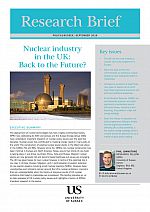
Links between civil and military nuclear power
Posted: 18th July 2020
SPRU – Science Policy Research Unit

Links between civil and military nuclear power
Nuclear technology – original military applications
Ever since the early development of nuclear technology accelerated during the Second World War, it has been clear that there are strong links between civil and military applications of nuclear power. Major nuclear industrial infrastructures were built during the War to produce materials for nuclear weapons. Early reactors were designed especially for this purpose. After the War, an entirely different kind of nuclear reactor was developed to fit inside the confined spaces of the submarines, whose stealth and endurance still gives them the key role in the nuclear arsenals of the world’s biggest military powers.
Civil and military use of nuclear infrastructure
Nuclear infrastructures with joint civil and military rationales continue to be the main bone of contention in current global tensions around nuclear proliferation. Despite many efforts to establish new designs of nuclear reactors, the only ones that have so far been widely adopted for civilian power generation are those that descend from these military designs originally optimised for either the production of fissile materials or submarine propulsion. A key problem for the nuclear industry is that dominant reactor designs were not optimized from the beginning for the production of safe, economic civilian electrical energy. Yet military-derived reactor designs have become so locked-in, that it is now difficult to replace them.
Many material links between civil and military nuclear technologies are very well documented. Involving types of plutonium, uranium or tritium used in bomb-making, for instance, these material links form the central focus of major international legal and political regimes. Over the past few years, a key strand of research at SPRU has focused more on the less well-understood industrial interdependencies between civil and military nuclear power. Particular attention has been given to the question of how imperatives to sustain national industrial capabilities to construct, maintain and operate nuclear-propelled submarines seems at least partly to drive ambitious nuclear new build agendas in certain countries.
Nuclear submarines
Nuclear ballistic missile submarines are often recognised to be the most complex and demanding industrial artefacts that have ever been developed. It is a big struggle in a globalizing world, to retain the national industrial capacities and expertise to build and operate these extraordinary machines. Without a healthy ongoing national civil nuclear power programme, even the richest countries would find it effectively impossible to cover the enormous costs of the large engineering, regulatory, research and training infrastructures necessary to maintain these nuclear capabilities.
Civil nuclear power and military motivations
SPRU research is showing that it is the military incentives to maintain this ‘nuclear industrial base’ that are largely driving the otherwise odd intensity of current Government commitments to nuclear power. It is also these aims that are evidently largely responsible for pressures for a new generation of ostensibly civilian ‘small modular reactors’, which are also in reality optimized around military submarine design requirements and so once again poorly suited to commercial power production.
With particular reference to the UK, but also focusing on other countries, SPRU research on this topic is illuminating an issue that has never before been acknowledged in civil energy policy debates. This issue is, that the intensity of official commitments to civil nuclear power are (although typically justified in other ways), to a large extent driven by these undeclared military motivations. As a result, a significant part of the costs of military nuclear capabilities are being effectively subsidized by electricity consumers, in ways that are off the public books and away from policy scrutiny. As nuclear power is increasingly recognized to be prohibitively expensive compared to other low carbon energy options, it is becoming more and more difficult to conceal this problematic situation.
SPRU research in this area aims to help foster more rigorous and accountable policy discussions over key implications of military nuclear infrastructures. We want to help inform debates in the UK and some other countries, over the reasons why nuclear technologies appear to be especially prioritised over increasingly favourable low carbon alternatives. Whatever side of the argument is favoured, the key issues are around protecting healthy democratic debate over crucial areas of policymaking with extremely high stakes.
Our latest work in this area
New research by Professor Stirling and Dr Johnstone, presents a global picture of industrial interdependencies between civil and military nuclear infrastructure.
The research appeared for the first time in the World Nuclear Industry Report 2018 (launched at Chatham House on 4 September 2018). The study is provided in full in SPRU Working Paper 2018-13.
Research Brief: Nuclear industry in the UK: Back to the future?

Nuclear industry in the UK: Back to the Future? [PDF 603.35KB]
